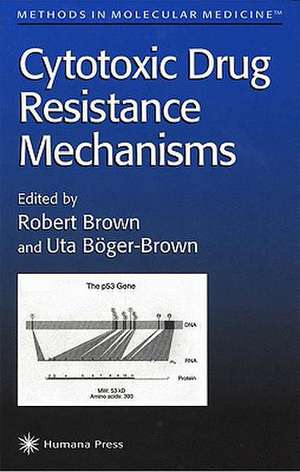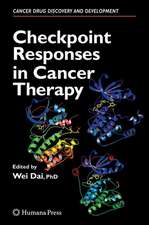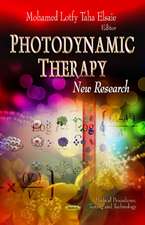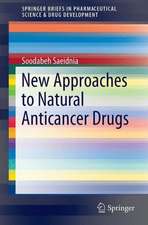Cytotoxic Drug Resistance Mechanisms: Methods in Molecular Medicine, cartea 28
Editat de Robert Brown, Uta Böger-Brownen Limba Engleză Hardback – 5 apr 1999
| Toate formatele și edițiile | Preț | Express |
|---|---|---|
| Paperback (1) | 896.91 lei 6-8 săpt. | |
| Humana Press Inc. – 9 noi 2010 | 896.91 lei 6-8 săpt. | |
| Hardback (1) | 720.84 lei 6-8 săpt. | |
| Humana Press Inc. – 5 apr 1999 | 720.84 lei 6-8 săpt. |
Din seria Methods in Molecular Medicine
- 5%
 Preț: 1278.74 lei
Preț: 1278.74 lei - 15%
 Preț: 655.78 lei
Preț: 655.78 lei - 5%
 Preț: 1106.50 lei
Preț: 1106.50 lei - 5%
 Preț: 727.44 lei
Preț: 727.44 lei - 5%
 Preț: 1108.72 lei
Preț: 1108.72 lei - 15%
 Preț: 650.55 lei
Preț: 650.55 lei - 5%
 Preț: 735.66 lei
Preț: 735.66 lei - 18%
 Preț: 947.35 lei
Preț: 947.35 lei - 18%
 Preț: 948.92 lei
Preț: 948.92 lei - 5%
 Preț: 1114.54 lei
Preț: 1114.54 lei - 5%
 Preț: 1114.91 lei
Preț: 1114.91 lei - 15%
 Preț: 658.55 lei
Preț: 658.55 lei - 5%
 Preț: 734.01 lei
Preț: 734.01 lei - 5%
 Preț: 1111.61 lei
Preț: 1111.61 lei - 5%
 Preț: 1104.32 lei
Preț: 1104.32 lei - 5%
 Preț: 723.21 lei
Preț: 723.21 lei - 5%
 Preț: 1106.13 lei
Preț: 1106.13 lei - 5%
 Preț: 723.05 lei
Preț: 723.05 lei - 5%
 Preț: 1108.35 lei
Preț: 1108.35 lei - 5%
 Preț: 723.42 lei
Preț: 723.42 lei - 5%
 Preț: 1115.65 lei
Preț: 1115.65 lei - 5%
 Preț: 786.86 lei
Preț: 786.86 lei - 5%
 Preț: 1133.01 lei
Preț: 1133.01 lei - 5%
 Preț: 1114.71 lei
Preț: 1114.71 lei
Preț: 720.84 lei
Preț vechi: 758.77 lei
-5% Nou
Puncte Express: 1081
Preț estimativ în valută:
137.95€ • 149.79$ • 115.88£
137.95€ • 149.79$ • 115.88£
Carte tipărită la comandă
Livrare economică 23 aprilie-07 mai
Preluare comenzi: 021 569.72.76
Specificații
ISBN-13: 9780896036031
ISBN-10: 0896036030
Pagini: 238
Ilustrații: XI, 238 p.
Dimensiuni: 155 x 235 x 19 mm
Greutate: 0.54 kg
Ediția:1999
Editura: Humana Press Inc.
Colecția Humana
Seria Methods in Molecular Medicine
Locul publicării:Totowa, NJ, United States
ISBN-10: 0896036030
Pagini: 238
Ilustrații: XI, 238 p.
Dimensiuni: 155 x 235 x 19 mm
Greutate: 0.54 kg
Ediția:1999
Editura: Humana Press Inc.
Colecția Humana
Seria Methods in Molecular Medicine
Locul publicării:Totowa, NJ, United States
Public țintă
Professional/practitionerCuprins
Drug Resistance.- Cell Sensitivity Assays.- Cell Sensitivity Assays.- Cell Sensitivity Assays.- Analysis of Apoptosis in Tissue Sections.- Measurement of P-glycoprotein Function.- Measuring MDR-1 by Quantitative RT-PCR.- Microtiter Plate Technique for the Measurement of Glutathione in Fresh and Cryopreserved Lymphoblasts Using the Enzyme Recycling Method.- Measurement of Reduced Glutathione Using High-Pressure Liquid Chromatography.- Topoisomerase I and II Activity Assays.- 5-Fluorouracil Metabolizing Enzymes.- Measuring DNA Adducts by Immunoassay (ELISA).- Measuring Drug-DNA Adducts in Individual Cells.- Measurement of Drug-Induced DNA Interstrand Crosslinking Using the Single-Cell Gel Electrophoresis (Comet) Assay.- PCR Analysis of Microsatellite Instability.- O 6-Alkylguanine-DNA Alkyltransferase Assay.- Analysis of the p53 Status of Tumors.- Bcl-2 Family Immunohistochemistry.- Genetic Analysis of Drug Resistance by Fluorescence In Situ Hybridization.- Genetic Analysis of Drug Resistance by Reverse In Situ Hybridization.
Recenzii
"This timely book will greatly benefit a wide array of individuals interested in cancer therapeutics, at both the clinical and basic science level. The editors and contributors did a good job of concisely presenting otherwise disparate methodologies in the context of a broad research field with the uniting purpose of understanding the biology underlying resistance to cancer chemotherapy. "-Doody's Health Sciences Book Review Journal
"...the editors have managed to successfully compile a brief review of cytotoxic drug resistance mechanisms and an extensive manual of protocols for laboratory experimentation in this extremely important area of research. It is clear that any laboratory scientist in this field must be aware of the difficulty of translation to the clinic of anti-drug resistance lead compounds, and should keep a copy of this book within reach. Congratulations to the editors for assembling an important mix of laboratory and clinical scientists to create this volume."-The Quarterly Review of Biology
"This book provides a comprehensive guide to a range of methods to a diverse range of drug resistance mechanisms including: Multidrug resistance (P-glycoprotein and MDR-1 gene analysis); cell sensitivity (clonogenic and MTT assays); Apoptosis (TUNEL, p 53 and Bcl-2); Glutathione-associated resistance (enzyme based glutathione assay and a HPLC method for reduced glutathione); DNA repair defects and damage (topoisomerase activity assays and DNA adduct measurements); 5-Fluorouracil metabolizing enzymes; Genetic analysis including microsatellite instability and fluorescence in situ hybridization....The methods are clearly described with each chapter consisting of an introduction and well described materials and methods sections. An extremely useful addition to most chapters was the "Notes" section where the respective authors suggest very useful hints, problem solving approaches and advice on the interpretation of results....the book is well written and useful addition to any laboratory investigating drug resistance in either clinical samples or tumor cell lines."-Cancer Forum
"...a useful collection of protocols that can be used in the oncology laboratory for studies on drug resistance and molecular pharmacology....It should find its place on the library shelves of many laboratories of oncology."- Annals of Oncology
"...the editors have managed to successfully compile a brief review of cytotoxic drug resistance mechanisms and an extensive manual of protocols for laboratory experimentation in this extremely important area of research. It is clear that any laboratory scientist in this field must be aware of the difficulty of translation to the clinic of anti-drug resistance lead compounds, and should keep a copy of this book within reach. Congratulations to the editors for assembling an important mix of laboratory and clinical scientists to create this volume."-The Quarterly Review of Biology
"This book provides a comprehensive guide to a range of methods to a diverse range of drug resistance mechanisms including: Multidrug resistance (P-glycoprotein and MDR-1 gene analysis); cell sensitivity (clonogenic and MTT assays); Apoptosis (TUNEL, p 53 and Bcl-2); Glutathione-associated resistance (enzyme based glutathione assay and a HPLC method for reduced glutathione); DNA repair defects and damage (topoisomerase activity assays and DNA adduct measurements); 5-Fluorouracil metabolizing enzymes; Genetic analysis including microsatellite instability and fluorescence in situ hybridization....The methods are clearly described with each chapter consisting of an introduction and well described materials and methods sections. An extremely useful addition to most chapters was the "Notes" section where the respective authors suggest very useful hints, problem solving approaches and advice on the interpretation of results....the book is well written and useful addition to any laboratory investigating drug resistance in either clinical samples or tumor cell lines."-Cancer Forum
"...a useful collection of protocols that can be used in the oncology laboratory for studies on drug resistance and molecular pharmacology....It should find its place on the library shelves of many laboratories of oncology."- Annals of Oncology
Textul de pe ultima copertă
In Cytotoxic Drug Resistance Mechanisms, leading clinical and laboratory scientists describe cutting-edge methods for examining the mechanisms of cellular resistance to anticancer cytotoxics in human tumors. The protocols contain detailed instructions and extensive troubleshooting tips that allow researchers effectively to study a wide variety of drug resistance mechanisms, including aspects of drug-induced cell death, drug uptake/efflux, drug metabolism, and DNA repair. Each method is designed to help identify the correlation between molecular and biochemical data and the clinical responses of the patient.
Cytotoxic Drug Resistance Mechanisms makes it possible to test established and laboratory-derived hypotheses with clinically derived tumor samples. State-of-the-art and readily reproducible, the methods presented here afford basic and clinical scientists a powerful complement of tools for investigating all the clinically relevant mechanisms used as markers of the biological response to anticancer chemotherapeutics today.
Cytotoxic Drug Resistance Mechanisms makes it possible to test established and laboratory-derived hypotheses with clinically derived tumor samples. State-of-the-art and readily reproducible, the methods presented here afford basic and clinical scientists a powerful complement of tools for investigating all the clinically relevant mechanisms used as markers of the biological response to anticancer chemotherapeutics today.




















